Does the hood fit between cabinets? How deep are the cabinets? Is there a soffit or does the hood need to go all the way to the ceiling? What kind of wood, stone or tile are you using in your kitchen? How big of a stove will you use, and how much smoke does your style of cooking regularly create?
These are the kind of questions your hood designer/fabricator should be asking you, in detail. That's one of the signs they're planning carefully, anticipating how your hood with fit within the whole of the project, and what you will have to deal with when it's time to install your kitchen hood.
HOW DO YOU LIKE TO COOK?
Cooking with woks, grills, or with multiple burners (four to six) at the same time, lots of frying or heavy boiling require larger blowers. Planning to cook greasy meat at extreme heat with lots of onions and garlic? Better get a really big blower unit.

ON CAPTURING SMOKE
The width of your range hood should be at least as wide as your stove, even better to add an additional four to twelve inches, both for aesthetics and performance. The depth of your range hood should be about 24 to 26 inches deep, but can be deeper as long as it is high enough for head clearance.
HOW FAR ABOVE THE STOVE TOP?
The bottom of the range hood should be 30"-36" inches above the surface of the range, but it can be higher depending on local building codes. A common height for larger range hoods is 32" to 40" inches above the range surface. Your height is also an important consideration – the space needs to be comfortable for you to work in. Increasing the height of the range hood (typically to accommodate taller users) reduces the effectiveness of the blower unit. However, this can be offset somewhat by using a more powerful blower, or increasing the hood’s capture area (i.e. wider or deeper).
TYPE OF STOVE
A gas range with several high BTU (British Thermal Unit) output burners will require a larger blower unit than an electric range that has just four standard burners. In some cases, a very large or double range with grills and wok burners may need double blowers or commercially sized blower units.
Here are some basic shapes to consider for a kitchen hood. The material combination and width of straps will alter the sense of style or character for different Arts & Crafts tastes, whether formal or informal. It would be suggested for a craftsman bungalow or rustic cabin, for example, in most cases, to use wide forged steel straps, heavier shapes, less refined texturing and finishes. However, one should not be afraid to consider thoughtfully planned juxtaposition of influences within a home that takes its primary design directives from another stylistic branch of Arts & Crafts. When done properly, this mixing of styles can create an exciting space; the key is balanced blending of forms, structural members and embellishments that are sympathetic to each other. It is a good idea to establish a design "vocabulary", a set of parameters around which decisions are made that point the project in a direction and help keep things on track towards a whole house harmony. While these may, and should, fluctuate throughout the remodel or construction process, a design "compass" is a helpful.
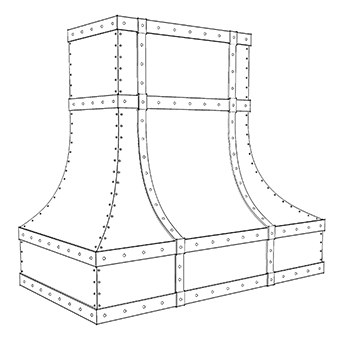
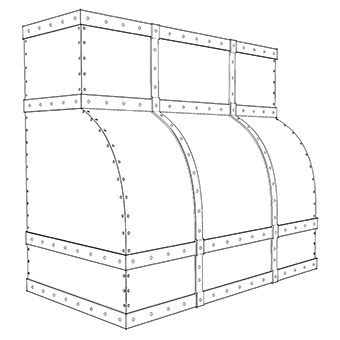
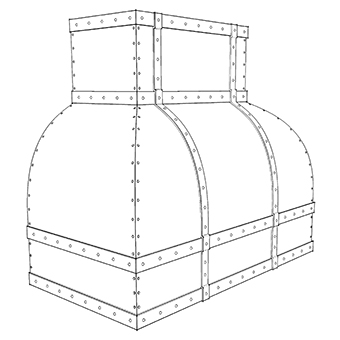
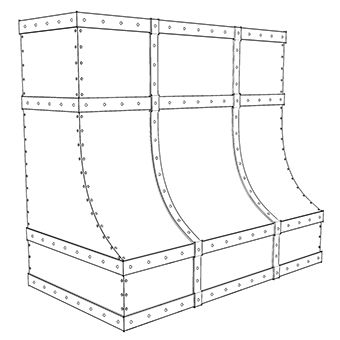

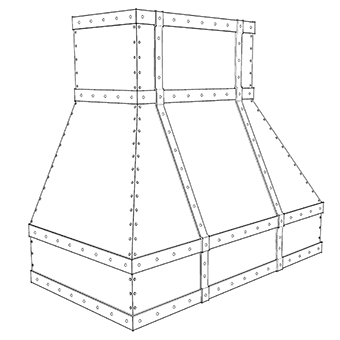
GUIDELINES FOR BLOWERS TO PULL AWAY WISPING VAPORS FROM THE STOVE
Rated in CFM (cubic feet of air per minute).
200-300 CFM: barely adequate for the small, low-usage electric ranges. These blowers often have a blade type fan that is noisier for their size than a “squirrel-cage” type blower.
400 CFM: adequate for electric ranges with moderate usage or gas ranges with low usage.
600-800 CFM are good for gas ranges of modest use or electric heavy use.
900 CFM-1500 CFM: for heavy ventilation needs. Big grease.
Consult with your architect or appliance manufacturer when in doubt about size of blower needed.
INTERNAL BLOWERS are available in capacities of 400-1200 CFM for usage as a single unit within the range hood, depending on model.
EXTERNAL BLOWERS are available in capacities of 600-1500 CFM. These blowers are mounted to the exterior of the building, which additionally reduces noise.
IN-LINE BLOWERS units that are mounted within a section of duct (usually in the attic) are available in various sizes for special situations. Access is important for servicing. Most blowers are available with variable or multiple speed settings to allow for lower capacity ventilation, this also helps keep them quieter. When in doubt, consider the larger CFM blower.
CLEANING TIPS
The easiest way to maintain the finish is to frequently wipe down the surface with mild soapy water. Should a heavier layer of dust or grease build up, a non-abrasive cleaning agent like “409” works well to clean the surface. To help seal in the patina, and slow the aging process, we finish our hoods with a warm coat of Johnson’s Paste Wax and a light buffing. Automotive-type wax also works well.
On stainless components use a stainless cleaner like Sheila 3M Stainless cleaner, or other off the shelf stainless cleaner/polish works well. DO NOT USE STEEL WOOL for any cleaning, as it will leave tiny steel fibers that rust. On mild steel hoods or hoods with steel parts an occasional very light coating of mineral oil or wax helps maintain the finish. Heavy steam or outside conditions can increase the need for more frequent oiling or waxing. Frequent light cleaning is much easier and safer than heavy cleaning done infrequently.





